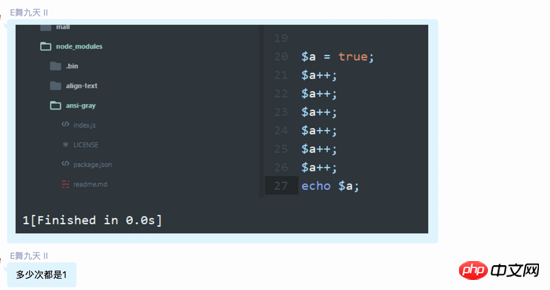 Backend Development
Backend Development
 PHP Tutorial
PHP Tutorial
 How to implement self-increment and self-decrement of PHP Boolean values
How to implement self-increment and self-decrement of PHP Boolean values
How to implement self-increment and self-decrement of PHP Boolean values
This article mainly introduces the implementation method of self-increasing and self-decreasing PHP Boolean values. It has a certain reference value. Now I share it with you. Friends in need can refer to it.
In the morning and After the business requirements battle was over, I was about to open the group to see if any experienced drivers had checked out the car. Suddenly I saw some messages from @E五九天II

He discovered that PHP The Boolean value of , no matter how many times it is incremented, the final output is 1
This is more interesting~
Self-increment and self-decrement, what is the difference between $a and $a We all know that
a means to take the address of a, increase the value of a in the memory, and then put the value in the register
a means to take the address of a, load the value of a into the register, and then add The value of a in the memory
I opened an editor to confirm the result
$a = true; var_dump(--$a); echo PHP_EOL; echo $a; $b = false; echo PHP_EOL; var_dump(++$b);
The final input result of the operation is as follows
bool(true)
1
bool(false)
I found that the result was not quite what I expected. PHP did not do anything for the auto-increment operation of Boolean values. Processing, and the reason why it is 1 after incrementing is because we use echo to output, resulting in the bool being forced to
to query the official documentation of PHP, but unexpectedly there is a line of obvious prompts
Note : Increment/decrement operators do not affect boolean values. Decrementing a NULL value has no effect, but increasing NULL results in 1.

Related recommendations:
Android programmers learn PHP development (5)-Boolean scientific notation-PhpStorm
The above is the detailed content of How to implement self-increment and self-decrement of PHP Boolean values. For more information, please follow other related articles on the PHP Chinese website!

Hot AI Tools

Undresser.AI Undress
AI-powered app for creating realistic nude photos

AI Clothes Remover
Online AI tool for removing clothes from photos.

Undress AI Tool
Undress images for free

Clothoff.io
AI clothes remover

AI Hentai Generator
Generate AI Hentai for free.

Hot Article

Hot Tools

Notepad++7.3.1
Easy-to-use and free code editor

SublimeText3 Chinese version
Chinese version, very easy to use

Zend Studio 13.0.1
Powerful PHP integrated development environment

Dreamweaver CS6
Visual web development tools

SublimeText3 Mac version
God-level code editing software (SublimeText3)

Hot Topics
 CakePHP Project Configuration
Sep 10, 2024 pm 05:25 PM
CakePHP Project Configuration
Sep 10, 2024 pm 05:25 PM
In this chapter, we will understand the Environment Variables, General Configuration, Database Configuration and Email Configuration in CakePHP.
 PHP 8.4 Installation and Upgrade guide for Ubuntu and Debian
Dec 24, 2024 pm 04:42 PM
PHP 8.4 Installation and Upgrade guide for Ubuntu and Debian
Dec 24, 2024 pm 04:42 PM
PHP 8.4 brings several new features, security improvements, and performance improvements with healthy amounts of feature deprecations and removals. This guide explains how to install PHP 8.4 or upgrade to PHP 8.4 on Ubuntu, Debian, or their derivati
 CakePHP Date and Time
Sep 10, 2024 pm 05:27 PM
CakePHP Date and Time
Sep 10, 2024 pm 05:27 PM
To work with date and time in cakephp4, we are going to make use of the available FrozenTime class.
 CakePHP File upload
Sep 10, 2024 pm 05:27 PM
CakePHP File upload
Sep 10, 2024 pm 05:27 PM
To work on file upload we are going to use the form helper. Here, is an example for file upload.
 CakePHP Routing
Sep 10, 2024 pm 05:25 PM
CakePHP Routing
Sep 10, 2024 pm 05:25 PM
In this chapter, we are going to learn the following topics related to routing ?
 Discuss CakePHP
Sep 10, 2024 pm 05:28 PM
Discuss CakePHP
Sep 10, 2024 pm 05:28 PM
CakePHP is an open-source framework for PHP. It is intended to make developing, deploying and maintaining applications much easier. CakePHP is based on a MVC-like architecture that is both powerful and easy to grasp. Models, Views, and Controllers gu
 How To Set Up Visual Studio Code (VS Code) for PHP Development
Dec 20, 2024 am 11:31 AM
How To Set Up Visual Studio Code (VS Code) for PHP Development
Dec 20, 2024 am 11:31 AM
Visual Studio Code, also known as VS Code, is a free source code editor — or integrated development environment (IDE) — available for all major operating systems. With a large collection of extensions for many programming languages, VS Code can be c
 CakePHP Creating Validators
Sep 10, 2024 pm 05:26 PM
CakePHP Creating Validators
Sep 10, 2024 pm 05:26 PM
Validator can be created by adding the following two lines in the controller.





